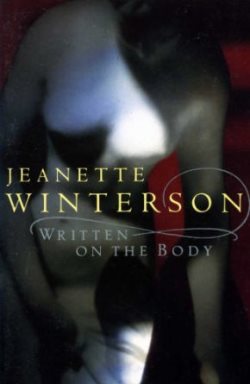This book is beautiful. I could sink into its words.
“I cannot think of the double curve lithe and flowing with movement as a bony ridge, I think of it as the musical instrument that bears the same root. Clavis. Key. Clavichord. The first stringed instrument with a keyboard. Your clavicle is both keyboard and key. If I push my fingers into the recesses behind the bone I find you like a soft shell crab. I find the openings between the springs of muscle where I can press myself into the chords of your neck. The bone runs in perfect scale from sternum to scapula. It feels lathe-turned. Why should a bone be balletic?”
Jeanette Winterson’s Written on the Body returns to a question raised in a previous post: what does it mean to leave a character’s gender unknown?
The narrator of Written on the Body is only “I,” un-named, un-gendered, ruminating on love and sex, failed relationships—some funny, some difficult—the consequences of decisions made and the pain of loss. I am rarely interested in stories about romantic relationships, but this is captivatingly told. The words intoxicate.
“Written on the body is a secret code only visible in certain lights: the accumulations of a lifetime gather there. In places the palimpsest is so heavily worked that the letters feel like Braille. I like to keep my body rolled up away from prying eyes. Never unfold too much, tell the whole story.”
What of gender?
The narrator has girlfriends and boyfriends (the girlfriends seem to leave the larger emotional and sexual mark), helps an anarcha-feminist girlfriend blow up urinals for being patriarchal symbols, invokes comparisons to female and male figures, talks about “my fellow man,” desires to penetrate, is assumed to have a boyfriend and is immediately accepted as having a girlfriend. Make of that what you will.
Louise, the narrator’s most important lover, says:
“When I saw you two years ago I thought you were the most beautiful creature male or female I had ever seen.”
This is the only point in Written on the Body where the narrator’s gender is raised—and thus left not only unknown, but a non-question. No one mentions it, talks about it, wonders about it. No one remarks on what the narrator wears. This makes explicit the narrator’s un-gendered position in the narrative.
Many readings are possible. Written on the Body won a Lambda Literary Award in the Lesbian Fiction category. It was mentioned in a panel about non-binary fiction at Nine Worlds Geekfest 2013.
I strongly resist the notion of gendering the narrator female or male. Written on the Body is clear in its subversion of gendering along the binary. It begs the reader to assume and be wrong. The narrator could be either gender. The question is: could the narrator be neither?
To me, the “male or female” in Louise’s words root the narrator’s gender in the binary, not beyond, but “male or female” could be a use of commonplace twentieth century language to say that not only is there no way to identify the narrator as a man or a woman, but there is no need. The narrator is not gendered because gender is irrelevant to them.
Maybe.
It is unknown.
I find my position unchanged from the last time I talked about this approach to gender. Like Siri Hustvedt’s The Blazing World, Jeanette Winterson’s Written on the Body belongs to its contemporary era, not the future or another world: it speaks to the 1990s and, still, to now. (I’d be very interested to hear what gender theorists expanding gender beyond the binary in the 1990s thought of it, as I was quite young then; my only framework for understanding my gender in the 1990s was George in Enid Blyton’s The Famous Five.) It frustrates me that the narrator is the only un-gendered person—I crave narratives with multitudes, normalised and varied, not a single person straining at the binary—and that I have to squint between the lines to see non-binary gender. It pleases me that no one in the book cares that the narrator’s gender is unknown. Written on the Body belongs to the conversation about gender in fiction, but I want more. I value these troublings of the binary, but—as I’ve said before—I want to go beyond.
Alex Dally MacFarlane is a writer, editor and historian. Her science fiction has appeared (or is forthcoming) in Clarkesworld, Interfictions Online, Gigantic Worlds, Solaris Rising 3 and The Year’s Best Science Fiction & Fantasy: 2014. She is the editor of Aliens: Recent Encounters (2013) and The Mammoth Book of SF Stories by Women (forthcoming in late 2014).










